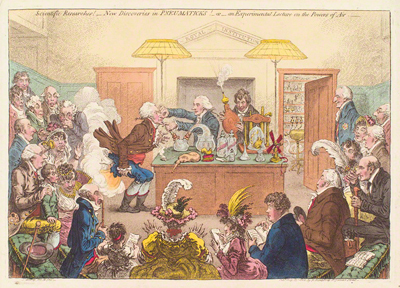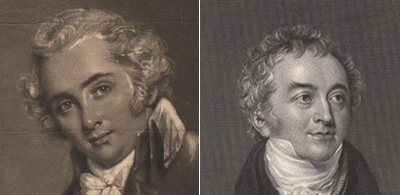Scientific Researches. New Discoveries in Pneumatics...
The 18th century is remembered as a great age of science in England. What are today household names in science and technology—Sir Isaac Newton, Henry Cavendish, Joseph Priestley, Michael Faraday, Sir Humphrey Davy, Sir Joseph Banks, and James Watt—all made significant contributions to their respective fields in the 18th century.
Something of the almost religious reverence with which scientific exploration was regarded is suggested by Joseph Wright of Derby's An Experiment on a Bird in an Air Pump (1768) which features the kind of striking chiarascuro most often associated with sacred subjects.

© National Gallery, London
But where a caricaturist perceives unquestioning reverence, he usually responds with ridicule. And whatever Gillray may have throught about scientific advancement, he produced one of his best caricatures poking fun at it.

© National Portrait Gallery, London
The setting of this print is the Royal Institution which had been founded in 1799 "with the aim of introducing new technologies and teaching science to the general public." In January 1802, the year of Gillray's print, there were lecture series at the Royal Institution advertised in the Morning Post Gazeteer on "Natural and Experimental Philsophy" by Thomas Young and on "Chemistry and its Application to the Arts" by Humphry Davy. Scarcely a month before this print appeared, Count Rumford (who stands proudly on the right) had reported to the members of the Institution that many of the renovations to "the arrangements and works of the house" were now complete. He noted that the
lecture-room had been finished and acknowledged to be one of the most beautiful and most convenienent scientific theatres in Europe. . . the repository already contains a considerable number of specimens of new and useful mechanical contrivances...[and the] chemical laboratory is finished, and furnished with complete apparatus.
In this print, Gillray shows the hilariously explosive and malodorous result of an experiment with certain gases. The lecture room is full of impressive-looking scientific instruments and includes wonderful caricatures of those attending the lecture as well as those performing the experiment. Nearly all the figures have been convincingly identified in the British Museum commentary on this print and in a helpful interactive version of the print on the Royal Institution site.
But there has been some confusion about the white haired gentleman at the center of the demonstration. The British Museum identifies him as Thomas Young who was delivering lectures in Natural Philosophy at that time. The Royal Institution identifies him (tentatively) as Thomas Garnett, a Physician, whom Young had replaced as lecturer in Natural Philosophy. But unlike Humphrey Davy (assisting with the bellows) who had been actively engaged with experiments in pneumatics, neither Young nor Garnett, so far as I can tell, had any apparent interest or expertise in the field. So they would not have been likely to have partnered with Davy in a lecture on gases.
But there was another well-known scientist who had both an interest in and experience with conducting experiments in pneumatics. And as another Scot, like Gillray, he may have been more familiar to the caricaturist, at least by reputation than either Garnett or Young. That was James Watt whose children had died of pulmonary issues. And, in fact, both Watt and Humphrey Davy had been part of the Bristol Pneumatic Institution before Davy moved on to the Royal Institution. Davy had been head of the laboratory in Bristol; Watt designed most of the equipment for the creation and administration of the gases. Watt never actually lectured at the Royal Institution, but Gillray's caricature (to my eye, at least) shows a greater resemblance to Watt than either Young or Garnett.

© National Portrait Gallery, London

© National Portrait Gallery, London
Sources and Reading
- Commentary from the British Museum on Scientific Researches. New Discoveries in Pneumatics...
- Draper Hill, Fashionable Contrasts, 1966, #93
- "Pneumatic_Institution," Wikipedia
- "James Watt," Wikipedia
- Thomas Wright and R.H. Evans, Historical and Descriptive Account of the Caricatures of James Gillray #520
Comments & Corrections
NOTE: Comments and/or corrections are always appreciated. To make that easier, I have included a form below that you can use. I promise never to share any of the info provided without your express permission.